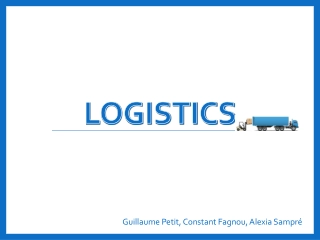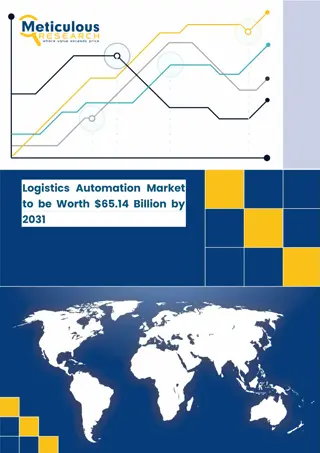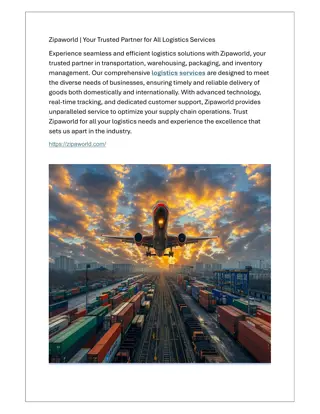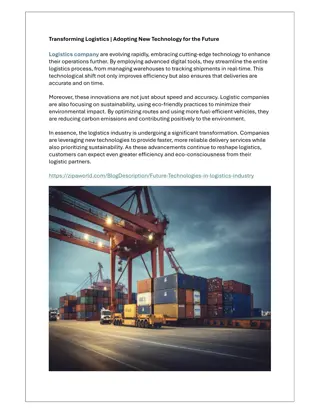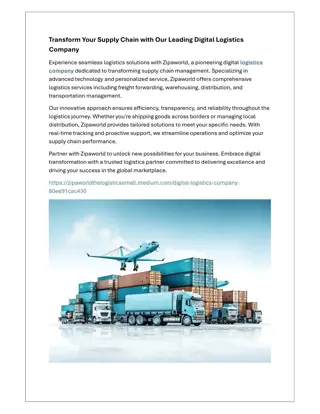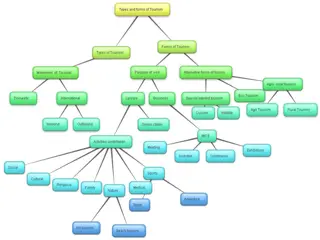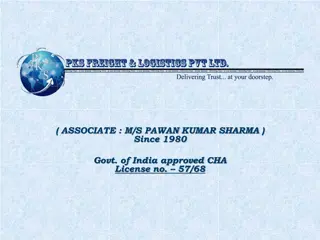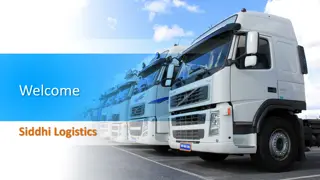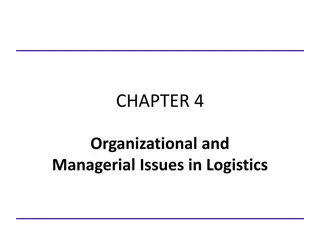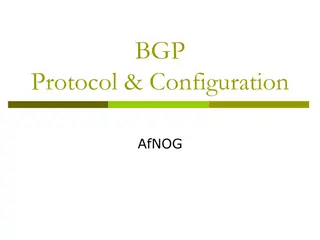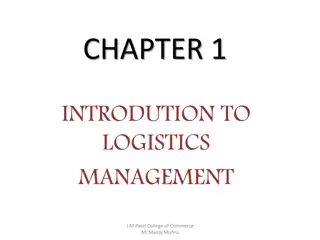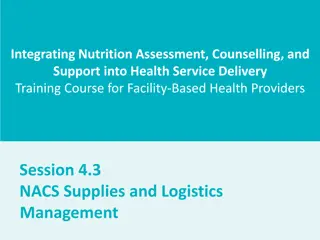Understanding Logistics Operations: Inbound and Outbound Strategies
Logistics, an integral part of supply chain management, involves the planning, implementation, and control of efficient flow and storage of goods, services, and information. This includes inbound logistics for materials entering the organization from suppliers, and outbound logistics for delivering materials to customers. Inbound logistics focus on procurement and materials management, while outbound logistics cover activities like warehousing, transportation, and customer service. Both play vital roles in ensuring smooth operations and customer satisfaction.
Download Presentation

Please find below an Image/Link to download the presentation.
The content on the website is provided AS IS for your information and personal use only. It may not be sold, licensed, or shared on other websites without obtaining consent from the author. Download presentation by click this link. If you encounter any issues during the download, it is possible that the publisher has removed the file from their server.
E N D
Presentation Transcript
OUTLINE 1. Introduction to Logistics 2. Warehouse and Inventory 3. Transportation Management 4. Labeling and packaging 5. ICT and Logistics 2
CHAPTER ONE Introduction to Logistics 3
Definition and concepts of logistics Logistics is part of the supply chain process that Plans, implements, and controls the efficient, effective forward and reverses flow and storage of goods, services, and related information between the point of origin and the point of consumption in order to meet customers requirements Logisticsrefers to the function responsible for all aspects of the storage and movement of materials on their journey from original suppliers through to final customers 4
logistics is classified into two groups (direction) Inbound and outbound logistics Inbound (inward) logistics: Moving materials into the organization from suppliers Procurement and the related materials management are among the major components of inbound logistics. It links members in the supply chain and assures the quality of suppliers in that chain 5
Materials management are a part of the inbound logistics system that can be described as the planning and control of the flow of materials. Whereas, logistic usually includes the activities of procurement, warehousing, production planning, inbound transportation, receiving, inventory management and control, and scrap disposal materials quality control, 6
Outbound (outward) logistics Moving materials out to customers Starts at the end of the production line and ends with the allocation to or arrival at the customer. Planning, controlling, and monitoring of the physical flow of goods as well as the associated flow of information are the main activities under outbound logistics. 7
Besides, it covers the processes of warehousing, transportation, and handling as well as picking and packing. Customer service, which is related to final output, is a critical element of outbound logistics it is not only about good service levels but also the financial costs incurred from providing quality customer services 8
logistics is responsible for moving both tangible goods and intangible services This might include materials, components, finished products, people, information, paperwork, messages, knowledge, consumables, energy, money, and anything else needed by operations 9
Materials management & Physical distribution Materials management (MM): Is moving materials within the organization (i.e. collecting from internal suppliers and delivering to internal customers). Controls the movement of materials within an organization. It includes production planning; demand forecasting; and purchasing and inventory management. 10
Physical distribution (PD): It comprises all the functions of movement and handling of goods particularly transportation, transshipment, warehousing services and trade, wholesale and, retail services. Physical distribution refers to the movement of goods outward from the end of the assembly line to the customer. 11
Role and importance of logistics A. Creation of time and place utility B. Order processing C. Inventory management D. Transportation 12
A) Creation of time and place utility Logistics create time and place utility through their ability to deliver The right product To the right customer At the right place, In the right condition and right quantity At the right time, at the right (lowest possible) costs 13
B) Order processing Order processing involves all the activities in the order cycle, including collecting, checking, entering and transmitting order information. The information collected will provide useful data for market analysis, financial planning, production scheduling and logistics operations. 14
C. Inventory management: In this aspect, logistics facilitates proper management of inventory levels that are helpful to serve the demand in a supply chain D. Transportation: is concerned with the ways in which physical items, for example, materials, components and finished products, are transferred between different parties 15
Basics of Logistics Integration As industrial activities extend globally, logistics will involve more material and information flows. In restructuring supply chains, logistics need to be managed as an integrated process that seeks to optimize these flows. The main role of integrated logistics is to extend functional management to include manufacturers customers, suppliers and 16
This is because companies can no longer afford to focus on supply-side efficiency alone. Rather, they need to use business strategies to integrate their demand and supply sides for achieving a competitive advantage. Decisions made in each area impact others so that it becomes a single, interdependent system 17
Levels of logistics integration The functional logistics integration: Mostly used in case of fragmented supply chain with many stakeholders involved helpful for integration of different divisions within the same company responsible for sales and distribution activities May develop into internal integration where different companies under the same corporate structure combine facilities, equipment, systems and personnel in more flexible modes of deployment. 18
The market channel or external integration: This is called the most extensive integration among industries. This level of integration requires that enterprises extend their internal supply chain process both upstream with suppliers of raw materials and downstream to final consumers. In this way, all companies in the supply chain are integrating their activities with those of other companies to achieve economies of joint operation. 19
Effects of integrated logistics on business practices Higher interdependency between firms interlinked within the business network It intensifies competition and increases the complexity of supply by expanding product variety, searching for higher efficiency while responding to diverse and rapidly changing markets 20
Changing the concept of corporate enterprise Organizations have shed peripheral activities to concentrate on core competencies that offer the promise of unique value. Greater external dependence therefore forces attention to inter-organizational relationships for coordinating activities and processes Outsourcing 21
Transformation of organizational structure of the corporation from a hierarchy to the point where knowledge is widely diffused throughout the organization and workers manage their own activities Changing the government environment, creating both problems and opportunities 22
CHAPTER TWO Warehouse and Inventory 23
Introduction to warehouse and warehousing Warehouse? Warehousing? Warehouse-keeper? Whywarehousing? 24
Warehousing refers to the activities involving storage of goods on a large-scale in a systematic and orderly manner and making them available conveniently when needed It creates time utility by bridging the time gap between production and consumption of goods. 25
A simple definition of a warehouse indicates that it is a planned space for the storage and handling of goods and materials. In general, warehouses are focal points for product and information flow between sources of supply and beneficiaries 26
Objective of warehouses maximum utilization of storage space; higher labor productivity; maximum asset utilization; reduction in material handling; reduction in operating cost; increased inventory turnoverand reduced order filling time. 27
Warehousing alternatives Three types Private warehouses, 1. 2. Public warehouses and 3. Contract warehouses 28
The private warehouses It refers to those owned or leased by the product owner. control is fully on the hand of the product owner; the product owner exercises overall control on warehouse management. provide market presence to the product owner and are considered to be cheaper as there is no profit to be added to the cost 29
The public warehouses Is available to companies on hire Public warehouses are characterized by overhead costs distributed over large customer base, offer expertise in management since warehousing is their core business; flexibility of location, significant economies of scale; several users and resultant volume and benefits in transportation costs. classified into five categories:- general merchandise, Refrigerated, Special commodity, Bonded and Household goods and furniture. 30
Contract warehouses In this case, contract warehouse operators take over logistics responsibility from manufacturing company. product owner gets the benefit of management expertise of the warehouse owner; As the warehouse owner centrally controls several warehouses, product owners get the benefit of shared resources with several clients. This brings down the cost. 31
Warehouse operation and management Warehouse Operation Receiving goods and accepting responsibility Identifying goods using place, label, color code and etc. Sorting out the received goods for appropriate storage area Dispatching goods to storage for ease of accessibility Holding goods for security against pilferage and deterioration 32
Selecting, retrieving, packing and grouping items according to customers order for dispatch Marshaling goods( i.e. check whether the items of a single order are complete and order records are updated) Dispatching goods using the proper transport and preparing records and advices-of stocks and replenishment requirements. 33
Warehouse management deals with receipt, storage and movement of goods, normally finished goods, to intermediate storage locations or to final customer The objective of warehouse management is to help in optimal cost of timely order fulfillment by managing the resources economically. 34
Is helpful to manage goods and space more effectively, to reduce costs and waste, and to gain control over warehouse operations Moreover, with access to real-time and accurate inventory data, warehouse professionals can possibly save time in locating items or performing physical inventories Helps to trace items by lot or serial numbers to quickly identify from where the items were purchased, how they were used in the production processes, and where they were sold. 35
Warehouse management system = control the movement and storage of materials within a warehouse and the associated transactions, including shipping, receiving, put away and picking. Is also helpful to direct and to optimize stock put away based on real time information about the status of bin utilization. For efficiency = utilize Auto ID Data Capture (AIDC) technology, such as barcode scanners, mobile computers, wireless LANs and potentially Radio-frequency identification (RFID). 36
Major objectives of a warehouse management system To provide a set of computerized procedures to handle the receipt of stock and returns into a warehouse facility to model and manage the logical representation of the physical storage facilities to manage the stock within the facility and to enable a seamless link to order management in order to pick, pack and ship product out of the facility processing and logistics 37
Economic benefits of warehouses Five movement consolidation, break-bulk, cross-dock, processing (postponement) and stock pilling. 38
The movement consolidation benefit It indicates that warehouses reduce transportation cost by consolidating movement. Several plants supply their products for the same customer to a warehouse and from this warehouse the products are sent in bulk shipment to the customer 39
Plant A (Product A for customer L) Customer L Consolidation Plant B (Product B for customer L) (Product A+ product B+ product C) Warehouse Plant C (Product C for customer L) Figure 1. The consolidation warehouse mechanism 40
The break-bulk benefit Goods from a plant for various customers are shipped to a warehouse obtaining the benefit of bulk shipment and then sent to the customers 41
Customer H Plant A: Product A for (H+I+J) customers Break-bulk Warehouse Customer I Customer J Figure 2. The break-bulk warehouse mechanism 42
The cross-dock benefit Several plants send their goods to the warehouse and from the warehouse the goods are moved across the dock to various customers as per order. A chain of retailers would like items as per movement of their stocks 43
Customer H (A+B+C) Plant A (Product A) Customer I (A+B+C) Plant B (Product B) Cross-dock Warehouse Customer J (A+B+C) Plant C (Product C) Customer K (A+B+C) Figure 3. The cross-dock warehouse mechanism 44
The processing/postponement benefit It implies that products uncommitted to a customer are sent to the warehouse and as per their order labels, they are attached to the products. Process of committing the product is postponed until just in-time The stock piling benefit of warehouses It indicates that, agricultural products which are produced during harvest are sold round the year and hence they need stocking. For example, woolen garments are sold during winter but produced earlier. 45
Service benefits of warehouses Five Spot stocking Assortment Mixing Production support Market presence 46
The spot stocking refers to a process of stocking products in strategically located warehouses during demand sensitive period. For instance, agricultural implements are spot stocked during the growing season. 47
The assortment service benefit of warehouses implies that a wholesaler would like to stock assortment of items from different manufacturers so that his/her customers and/or retailers can choose what they want. The wholesalers can stock assortments based on customer s requirement. 48
The mixing service benefit of warehouses indicates that, in the warehouse, products from various plants are received and combinations are prepared as per the order and sent to customers. The production support service benefit of warehouses implies that components and subassemblies required by several assembly lines are stocked economically in a common warehouse and supplied to lines. The Market presence service benefit of warehouses implies that warehouses offer quick response to customer demand. 49
Inventory management and control Inventory isa stock or store of goods. It also includes raw materials or stock incoming suppliers Two types of demand for inventory items Dependent demand Independent demand The dependent demand refers to those items that are typically subassemblies or component parts that will be used in the production of a final or finished product. The independent demand refers to inventory items that are the finished goods or other end items 50


